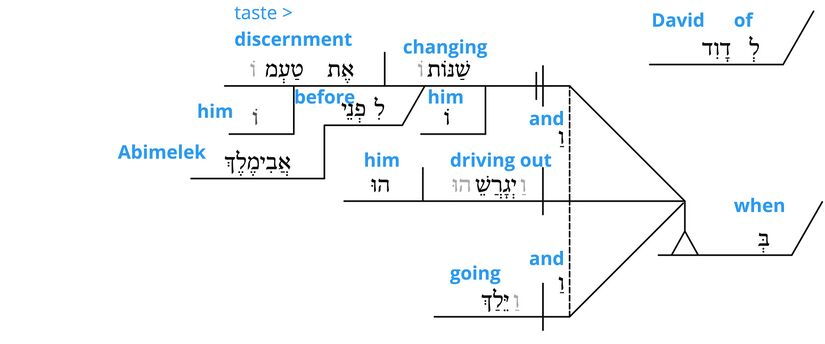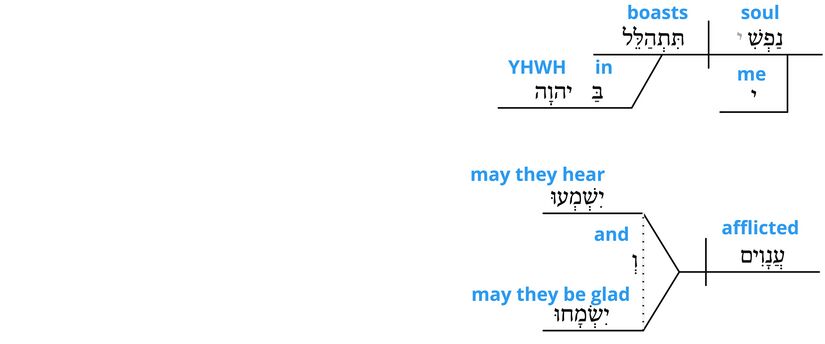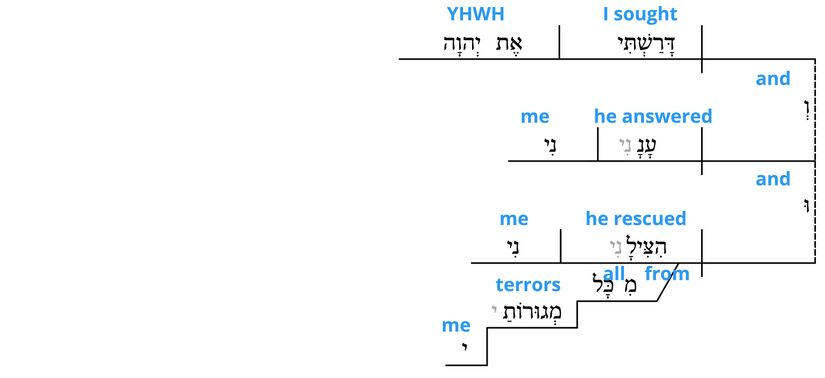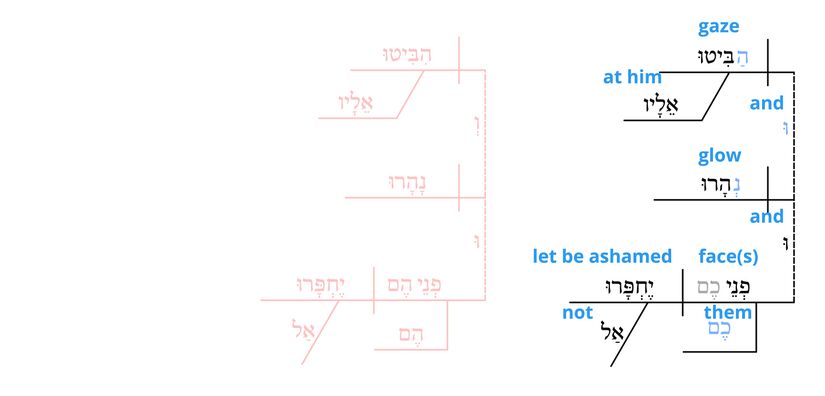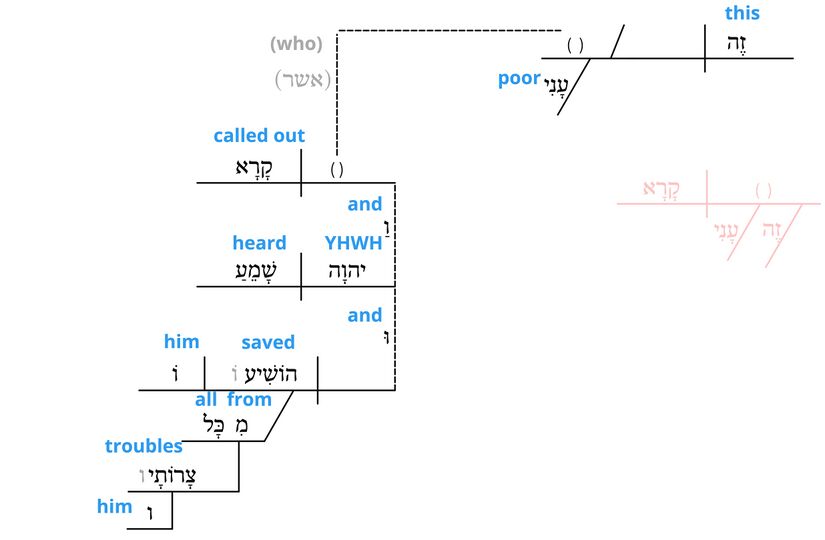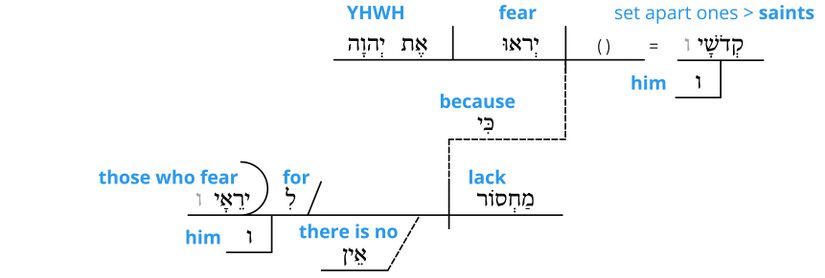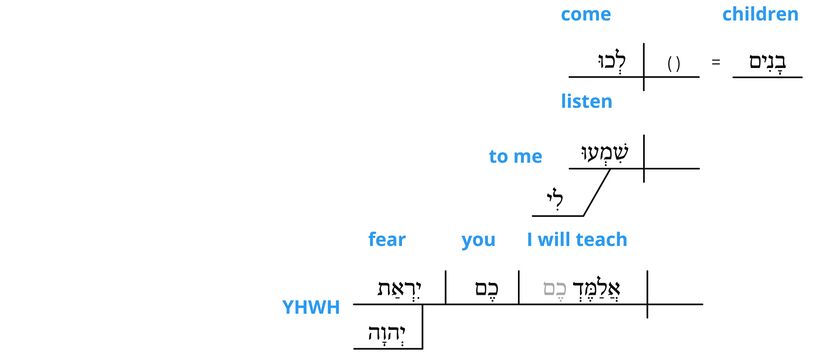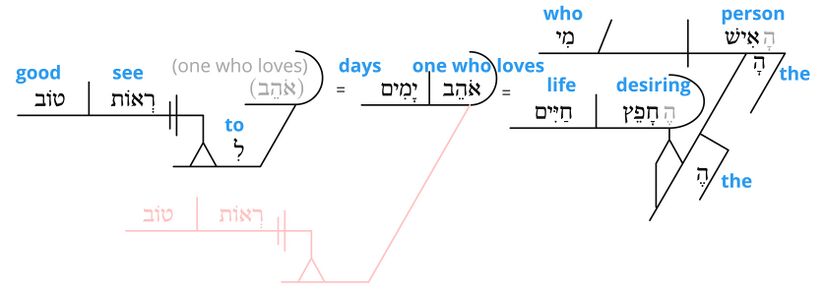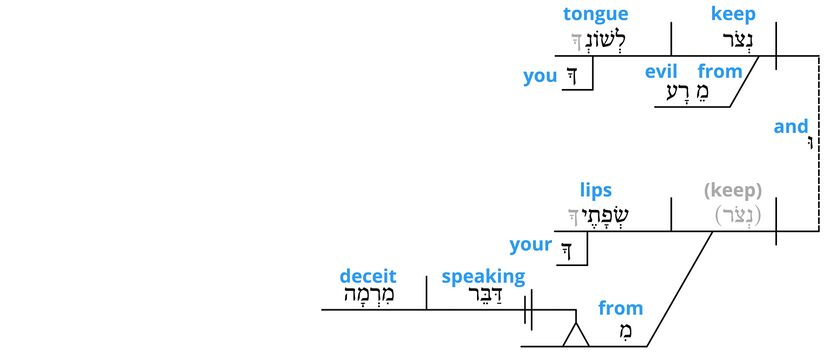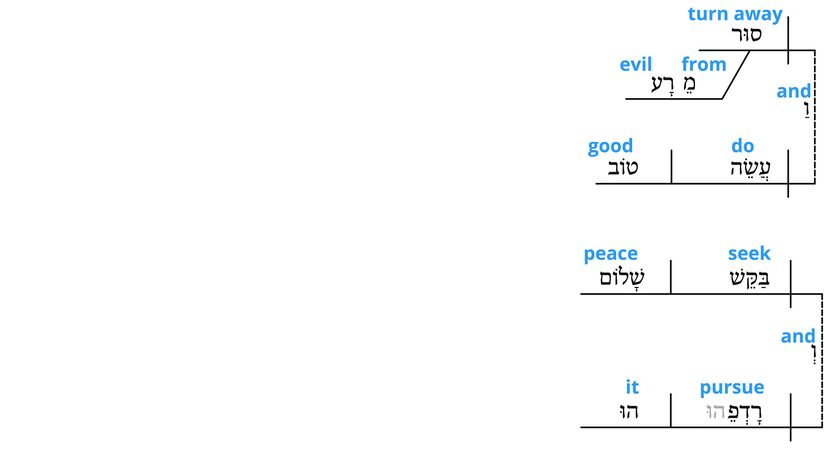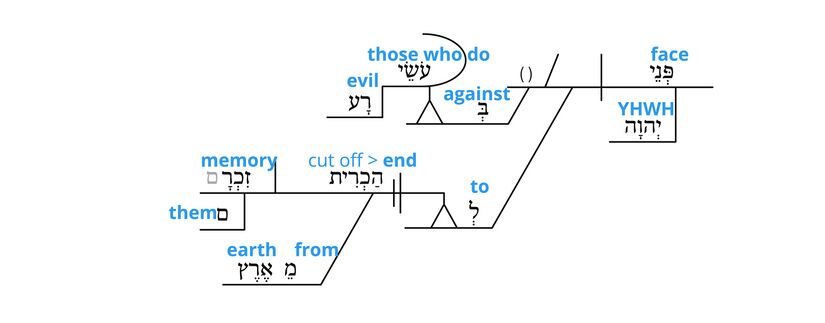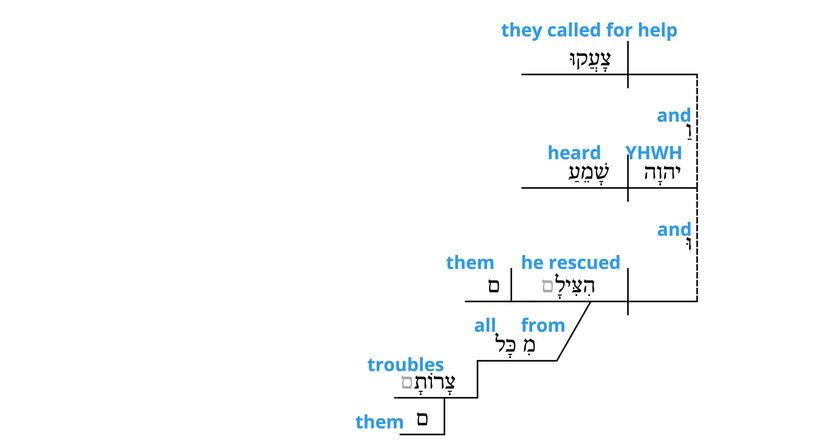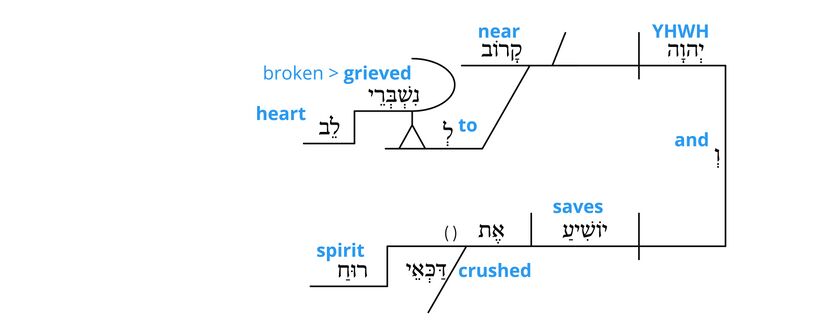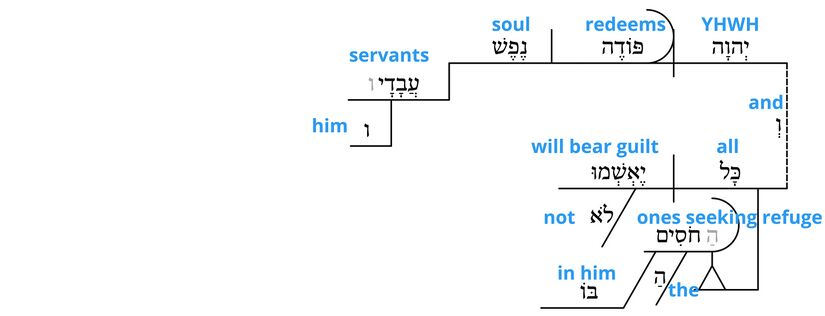Psalm 34 Grammar
From Psalms: Layer by Layer
Grammatical Diagram
The grammar layer visually represents the grammar and syntax of each clause. It also displays alternative interpretations of the grammar. (For more information, click "Grammar Legend" below.)
| Visualization | Description |
|---|---|
| The clause is represented by a horizontal line with a vertical line crossing through it, separating the subject and the verb. | |
| The object is indicated by a vertical line that does not cross the horizontal line of the clause. Infinitives and participles may also have objects. If the direct object marker (d.o.m.) is present in the text, it appears in the diagram immediately before the object. If the grammar includes a secondary object, the secondary object will appear after the object, separated by another vertical line that does not cross the horizontal line of the clause. | |
| The subject complement follows the verb (often omitted in Hebrew) separated with a line leaning toward the right. It can be a noun, a whole prepositional phrase or an adjective. The later two appear modifying the complement slot. | |
| When a noun further describes or renames the object, it is an object complement. The object complement follows the object separated by a line leaning toward the right. | |
| In a construct chain, the noun in the absolute form modifies the noun in the construct form. | |
| Participles are indicated in whatever position in the clause they are in with a curved line before the participle. Participles can occur as nominal, where they take the place of a noun, predicate, where they take the place of a verb, or attributive, where they modify a noun or a verb similar to adjectives or adverbs. | |
| Infinitives are indicated by two parallel lines before the infinitive that cross the horizontal line. Infinitive constructs can appear as the verb in an embedded clause. Infinitive absolutes typically appear as an adverbial. | |
| The subject of the infinitive often appears in construct to it. In this situation, the infinitive and subject are diagrammed as a construct chain. | |
| The object of the infinitive is indicated by a vertical line that does not cross the horizontal line of the infinitival clause. | |
| Modifiers are represented by a solid diagonal line from the word they modify. They can attach to verbs, adjectives, or nouns. If modifying a verb or adjective, it is an adverb, but if modifying a noun, it is an adjective, a quantifier, or a definite article. If an adverb is modifying a modifier, it is connected to the modifier by a small dashed horizontal line. | |
| Adverbials are indicated by a dashed diagonal line extending to a horizontal line. These are nouns or infinitives that function adverbially (modifying either a verb or a participle), but are not connected by a preposition. | |
| Prepositional phrases are indicated by a solid diagonal line extending to a horizontal line. The preposition is to the left of the diagonal line and the dependent of the preposition is on the horizontal line. They can modify verbs (adverbial) or nouns (adjectival). | |
| Embedded clauses are indicated by a "stand" that looks like an upside-down Y. The stand rests in the grammatical position that the clause fulfills. Extending from the top of the stand is a horizontal line for the clause. If introduced by a complementizer, for example כִּי, the complementizer appears before the stand. Embedded clauses can stand in the place of any noun. | |
| When clauses are joined by a conjunction, they are compound clauses. These clauses are connected by a vertical dotted line. The conjunction is placed next to the dotted line. | |
| Within a clause, if two or more parts of speech are compound, these are represented by angled lines reaching to the two compound elements connected by a solid vertical line. If a conjunction is used, the conjunction appears to the left of the vertical line. Almost all parts of speech can be compound. | |
| Subordinate clauses are indicated by a dashed line coming from the line dividing the subject from the predicate in the independent clause and leading to the horizontal line of the subordinate clause. The subordinating conjunction appears next to the dashed line. | |
| Relative clauses also have a dashed line, but the line connects the antecedent to the horizontal line of the relative clause. The relative particle appears next to the dashed line. | |
| Sentence fragments are represented by a horizontal line with no vertical lines. They are most frequently used in superscriptions to psalms. They are visually similar to discourse particles and vocatives, but most often consist of a noun phrase (that does not refer to a person or people group) or a prepositional phrase. | |
| In the body of the psalm, a horizontal line by itself (with no modifiers or vertical lines) can indicate either a discourse particle or a vocative (if the word is a noun referring to a person or people group). A discourse particle is a conjunction or particle that functions at the discourse level, not at the grammatical level. Vocatives can appear either before or after the clause addressed to them, depending on the word order of the Hebrew. | |
| Apposition is indicated by an equal sign equating the two noun phrases. This can occur with a noun in any function in a sentence. |
| Hebrew text colors | |
|---|---|
| Default preferred text | The default preferred reading is represented by a black line. The text of the MT is represented in bold black text. |
| Dispreferred reading | The dispreferred reading is an alternative interpretation of the grammar, represented by a pink line. The text of the MT is represented in bold pink text, while emendations and revocalizations retain their corresponding colors (see below). |
| Emended text | Emended text, text in which the consonants differ from the consonants of the Masoretic text, is represented by bold blue text, whether that reading is preferred or dispreferred. |
| Revocalized text | Revocalized text, text in which only the vowels differ from the vowels of the Masoretic text, is represented by bold purple text, whether that reading is preferred or dispreferred. |
| (Supplied elided element) | Any element that is elided in the Hebrew text is represented by bold gray text in parentheses. |
| ( ) | The position of a non-supplied elided element is represented by empty black parentheses. For example, this would be used in the place of the noun when an adjective functions substantivally or in the place of the antecedent when a relative clause has an implied antecedent. |
| Gloss text colors | |
|---|---|
| Gloss used in the CBC | The gloss used in the Close-but-Clear translation is represented by bold blue text. |
| Literal gloss >> derived meaning | A gloss that shows the more literal meaning as well as the derived figurative meaning is represented in blue text with arrows pointing towards the more figurative meaning. The gloss used in the CBC will be bolded. |
| Supplied elided element | The gloss for a supplied elided element is represented in bold gray text. |
v. 1
v. 2
v. 3
v. 4
- The phrase לַיהוָה could be interpreted a few ways:
- Option 1: The lamed marks the direct object (cf. LXX: μεγαλύνατε τὸν κύριον).
- Option 2 (preferred): Jenni groups this use of lamed with other times lamed is used with verbs of praise (ידה שיר זמר etc.) to indicate the one who is praised.[1] With verbs of praise, it’s not uncommon for the one who is praised to be either the direct object or the object of a lamed PP. Compare, for example, Ps. 111:1 (אוֹדֶה יְהוָה) and Ps. 118:1 (הוֹדוּ לַיהוָה). A good analogy to גדּל is the verb כבּד. For the verb כבד in the D stem, the person honored is always the direct object, except in Ps. 86:9 (וִֽיכַבְּד֣וּ לִשְׁמֶֽךָ). In the very same psalm we also find וַאֲכַבְּדָ֖ה שִׁמְךָ֣ (v. 12).
- Option 3: the phrase גדל ל is short for הבו גדל ל (which occurs in Deut 32:3; cf. Targum Pss. הבו רבותא קדם ייי עימי).[2]
v. 5
v. 6
- There is a textual problem in this verse. For a detailed discussion, see The Text of Ps. 34:6. In short, the MT translates "They looked... and were lightened: and their faces..." (KJV) (הִבִּיטוּ אֵלָיו וְנָהָרוּ).[3] By contrast, some modern translations (RSV, NRSV, CEV, NJB, NEB, GNB) have imperatives in the a-line ("look to him and be radiant!") and a 2mp suffix in the b-line ("your faces"). The latter option has the support of most of the ancient versions[4] and fits better within the syntactic context of v. 6 (jussive in the b-line), the wider semantic context of the first half of the psalm (vv. 2-11), and the psalm's historical background (v. 1; cf. 1 Sam. 21).
v. 7
- There are three options for interpreting the phrase זֶה עָנִי קָרָא :
- Option 1 (preferred): זה as subject and קרא is a relative clause; so Peshitta: ܗܢܘ ܡܣܟܢܐ ܕܩܪܝܗܝ ("this is a poor man who cried out to him").[5] Cf. Ps. 118:24.
- Option 2: זה as adjectival modifier (“this poor one”); so most English translations. See JM 143i - “In some very rare cases זה seems to be used adjectivally before the noun” (e.g., Ex. 32:1; 1 Sam. 21:12; Ct. 7:8; Isa. 23:13; Ps. 34:7; 104:25; 118:20).
- Options 3: Revocalize to עֳנִי (“affliction”). “Similarly, in Ps. xxxiv 7, the phrase זה עני ought to be understood as 'the poor man', lit., 'he possessing affliction or poverty' (reading עֳני for MT עָני).”[6] (cf. Waltke and O'Connor 19.5).
v. 8
- Here סָבִיב is taken as preposition (so BDB and DCH); see BDB on the construction סָבִיב לְ׳.
v. 9
- The כִּי clause belongs with both verbs. cf. Prov. 31:18 - טָ֭עֲמָה כִּי־טֹ֣וב סַחְרָ֑הּ; Gen. 1:4 - וַיַּ֧רְא אֱלֹהִ֛ים אֶת־הָאֹ֖ור כִּי־טֹ֑וב
v. 10
v. 11
v. 12
v. 13
- There are several possible interpretations of the word לִרְאוֹת in this verse:
- Option 1: The LXX (cf. 1 Pet. 3:10) apparently reads אֹהֵ֥ב יָ֝מִ֗ים לִרְא֥וֹת טֽוֹב as a single clause: ἀγαπῶν ἡμέρας ἰδεῖν ἀγαθάς ("coveting to see good days"). Cf. Peshitta: ܘܪܚܡ ܝܘܡ̈ܬܐ ܛܒ̈ܐ ܠܡܚܙܐ܂; Jerome: diligens dies videre bonos. But this interpretation involves grammatical discord: טוֹב (singular) modifies יָמִים (plural). It also requires a strained interpretation of the word order and prosodic structure.
- Option 2: לִרְאוֹת as purpose clause. The phrase אהב ימים corresponds to חפץ חיּים, "so that consequently לראות is a definition of the purpose."[7] "...loves many days, that he may see good?" (ESV) >> "...desires a long life to enjoy all good things" (NEB).
- Option 3 (preferred): לִרְאוֹת as complement of an elided אהב: "who loves days, [who loves] to see good" (cf. Isa. 56:10; Jer. 14:10; Hos. 10:11; 12:8). So Jenni.
v. 14
v. 15
v. 16
v. 17
v. 18
v. 19
v. 20
v. 21
- Most translations read v. 21 as an independent clause: "he protects all his bones" (Peshitta [ܘܢܛܪ], Jerome [custodit], NIV, NLT, ESV, NET, NEB, LUT, NGÜ, ELB, EÜ, GNB, ZÜR). But שמר is a participle, and a participle (unlike a finite verb) does not usually function as the main predication of a clause without an explicit subject. (The difficulty of the participle without an explicit subject is probably what led the LXX to redivide the lines: καὶ ἐκ πασῶν αὐτῶν ῥύσεται αὐτούς. // κύριος φυλάσσει πάντα τὰ ὀστᾶ αὐτῶν. Similarly, one Kennicott ms and one De Rossi ms read שומר יהוה.) Therefore, שמר is probably in apposition to יהוה at the end of the previous clause: "...the Lord // the one who protects all his bones" (cf. JPS85: "the Lord will save him from them all, Keeping all his bones intact...").
- This interpretation of the grammar is supported by the fact that v. 20 contrasts with v. 22 (the effects of רעה on the righteous and the wicked respectively). If v. 21 is not grammatically subordinated to v. 20, then the contrast is obscured.
- On the other hand, "the personal pronoun which would be expected as the subject of a participial clause is frequently omitted, or at least... the pronoun of the 3rd person הוא."[8]
v. 22
v. 23
Bibliography
- Allegro, John Marco. 1955.“Uses of the Semitic Demonstrative Element Z in Hebrew.” Vetus Testamentum, vol. 5, no. 3 July: pp. 309–12.
- Baethgen, Friedrich. 1904. Die Psalmen. Göttingen: Vandenhoeck und Ruprecht.
- Delitzsch, Franz. Biblical Commentary on the Psalms: Vol. 1. Translated by Eaton David. Vol. 1. New York: Funk and Wagnalls, 1883.
- Goldingay, John. 2006. Psalms: Psalms 1–41. Vol. 1. BCOT. Grand Rapids: Baker Academic, 2006.
- Hupfeld, Hermann. 1868. Die Psalmen. Vol. 2. Gotha: Friedrich Andreas Perthes.
- Jenni, Ernst. Die Hebräischen Präpositionen Band 3: Die Präposition Lamed. Stuttgart: Verlag W. Kohlhammer, 2000.
References
- ↑ Jenni 2000, 146; cf. Hupfeld 1868, 251.
- ↑ Cf. Hupfeld 1868, 251.
- ↑ The verbs "they looked... and were lightened" are often translated in a timeless sense (NIV, NLT, NET, GNT, JPS85). However, if the MT is correct, then the qatal forms plus the immediately surrounding past-tense context (vv. 5, 7) would strongly suggest reading these verbs as past tense: "They looked unto him, and were lightened" (KJV).
- ↑ LXX, Aquila, Peshitta, Jerome.
- ↑ Cf. Baethgen (1904) “Hier ist ein Dulder, welcher rief.” “זה עני ist nich ‘dieser Elende ̓, sondern das Pronomen steht deiktisch, und קרא ist mit dem Syrer als Relativsatz aufzufassen” (so NEB, JPS85, ELB, GNB, ZÜR, GWT; so Goldingay 2006, 475).
- ↑ (Allegro 1955, pp. 309–12)
- ↑ Delitzsch.
- ↑ GKC 116s; cf. Ps. 33:5; Job 12:17, 19-24.




















